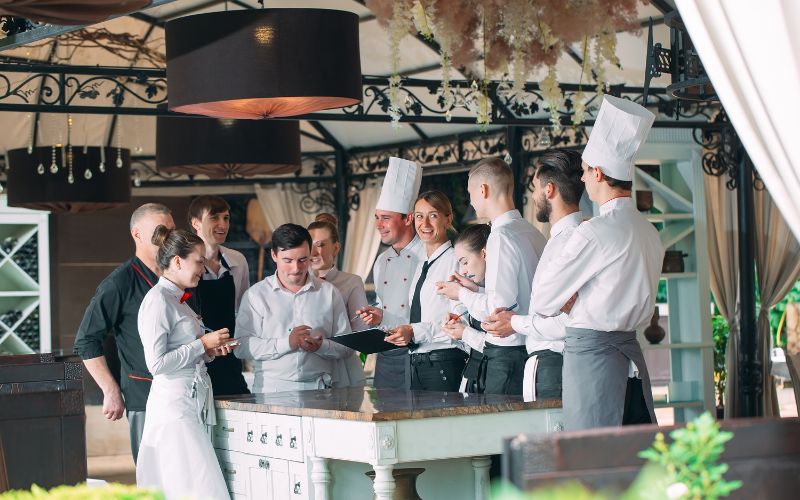In the restaurant world, having a great team is like having a secret ingredient for success. This article is all about “Tips to Successfully Manage Staff in a Restaurant.” We’ll share simple but powerful advice, covering everything from picking the right people and training them well to ensuring everyone gets along and conflicts are resolved. In a landscape where the quality and timely delivery of ingredients are paramount, effective staff management, coupled with a strategic alliance with food distributors, becomes the cornerstone of sustained excellence in the restaurant business. So, discover the secrets of managing a fantastic restaurant team and building strong partnerships with Food Distributors. It’s the recipe for success!
Hiring and Training

In the world of running a restaurant, it’s super important to have the right team, and that starts with how you hire and train your staff. First off, you want to make sure you’re getting people who are not just good at what they do but are also excited and ready to work in a restaurant.
When you’re picking new team members, it’s like detective work. You do thorough interviews and check their references, kind of like talking to their work buddies or bosses from before. This helps you know if they’re a good fit for your restaurant.
Now, once you’ve got your team, you want to make sure they know the ropes. So, providing them with training that covers everything they need to know is a must. This way, everyone on your staff is all set to give customers the best experience. So, when it comes to “Effective hiring and training strategies for restaurant staff,” these steps are like the secret sauce that makes your team and your restaurant stand out.
Communication
Effective communication is the heartbeat of a successful restaurant operation, and it involves a few key ingredients.
- Establishing clear communication channels is like creating a map for everyone to follow, making sure information flows smoothly.
- Regular staff meetings are like team huddles where everyone gets on the same page, discussing what’s working well and where improvements can be made.
- Encouraging open communication and feedback is crucial.
It’s like creating an environment where everyone feels comfortable sharing their thoughts and ideas, fostering a positive and collaborative atmosphere. When you put all these elements together, you’re essentially “Promoting effective communication among restaurant staff,” creating a well-connected team that can navigate the challenges of a bustling restaurant with ease.
Team Building

Creating a restaurant dream team isn’t just about having skilled individuals; it’s about turning a group of people into a unified and motivated force.
Fostering a positive work culture is like shaping the atmosphere of your restaurant. It’s about making sure everyone feels respected, supported, and enthusiastic about their work. When people enjoy their workplace, they’re more likely to give their best.
Think of organizing team-building activities as a way to mix things up. It’s like trying out new ingredients to see what flavours complement each other. Team-building activities help staff members get to know each other outside of the usual work routine. This connection often translates into smoother collaboration during busy hours.
Recognizing and rewarding achievements is the icing on the cake. When someone does a fantastic job, acknowledging it is like sprinkling appreciation on top. Whether it’s a verbal shout-out, a certificate, or a small reward, recognition motivates the team. It’s a powerful ingredient for boosting morale and encouraging everyone to keep giving their best effort.
When you put these elements together, you’re not just managing a group of employees; you’re crafting a team that works well together, supports each other, and is motivated to contribute to the success of the restaurant. This is the essence of “Building a cohesive and motivated restaurant staff team,” where every member is an essential part of the recipe for a thriving dining experience.
Scheduling and Shift Management
Ensuring operational efficiency in a restaurant bears resemblance to orchestrating a meticulously planned performance. Crafting efficient schedules mirrors the intricate composition of a musical piece, strategically aligning staffing levels with demand to avoid undue strain on the team. The objective is akin to orchestrating a symphony, where each element harmonizes seamlessly. Taking into account staff preferences and availability parallels the consideration of individual instrumentalists’ needs in a musical ensemble, fostering equilibrium between work commitments and personal life. Striking this balance is essential for maintaining a content and motivated team. Implementing effective shift management strategies resembles choreographing a dance, where tasks are distributed thoughtfully to maximize each team member’s strengths during peak operational hours. This strategic approach ensures a synchronized and efficient operation, enhancing both customer service and staff satisfaction. The overarching goal is to optimize staff schedules in the restaurant, cultivating an environment where each team member can perform at their best while maintaining a healthy work-life equilibrium.
Performance Evaluation
Evaluating performance in a restaurant is like fine-tuning a recipe; it requires attention to detail and a commitment to improvement.
Establishing clear performance metrics is the foundation, setting specific standards for what success looks like in each role. Providing constructive feedback is the seasoning in this process. It’s not just about pointing out mistakes; it’s about offering insights for improvement. Conducting regular performance reviews is like stepping back to taste the final product. Regular check-ins provide an opportunity to discuss achievements, challenges, and goals. It’s a chance to ensure everyone is on the same page and working towards a shared vision.
When these elements come together, you’re essentially practicing “Effective performance evaluation in restaurant staff management.” It’s about ensuring your team is not just meeting expectations but continually improving, creating a culture of excellence that elevates the overall dining experience.
Conflict Resolution
Navigating conflicts in a restaurant requires a strategic and delicate approach, similar to conducting a diplomatic mission. Addressing conflicts promptly and professionally is akin to swiftly responding to potential issues, ensuring they are resolved before they escalate. It’s about addressing concerns with a level of professionalism that maintains the dignity of all involved parties. Implementing a fair and transparent conflict resolution process is like establishing a set of rules for fair play. It ensures that everyone understands how conflicts will be addressed, promoting a sense of equity and trust within the team. Mediating disputes and fostering a positive work environment involves acting as a neutral party to help conflicting individuals find common ground. It’s like being a mediator in a negotiation, working towards resolutions that contribute to a harmonious workplace. When these elements are skilfully interwoven, you’re effectively “Handling conflicts among restaurant staff with finesse,” creating an atmosphere where conflicts are addressed promptly, fairly, and with a focus on maintaining a positive work environment.
Read More: How to Manage Rush Hours in the Restaurant
Conclusion:
In the intricate world of restaurant management, the significance of skilful staff management cannot be overstated. From meticulous hiring and nurturing a positive work culture to effective communication and conflict resolution, the key to a thriving restaurant lies in implementing these strategies. Emphasizing the need for adaptability to industry changes ensures that management practices stay relevant and effective. Encouraging a proactive and dynamic approach not only sustains a harmonious work environment but also positions the restaurant for enduring success. In conclusion, the amalgamation of these tips forms a comprehensive guide for successfully managing staff in a restaurant, fostering a workplace where both the team and the business flourish in the ever-evolving culinary landscape.






